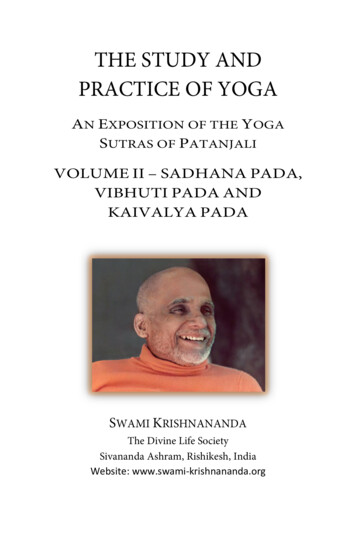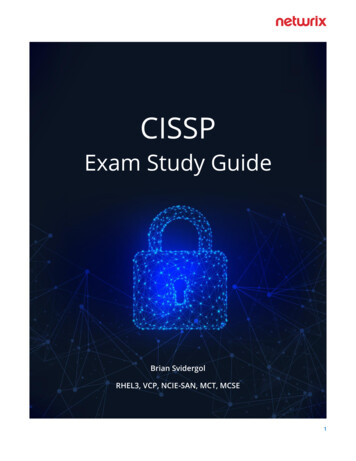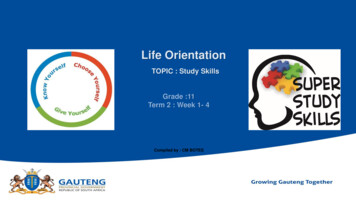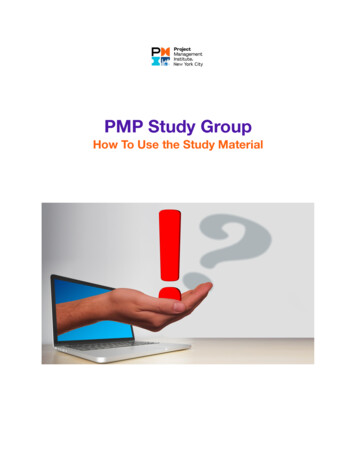
Transcription
THE STUDY ANDPRACTICE OF YOGAAN EXPOSITION OF THE YOGASUTRAS OF PATANJALIVOLUME II – SADHANA PADA,VIBHUTI PADA ANDKAIVALYA PADASWAMI KRISHNANANDAThe Divine Life SocietySivananda Ashram, Rishikesh, IndiaWebsite: www.swami-krishnananda.org
ABOUT THIS EDITIONThough this eBook edition is designed primarily fordigital readers and computers, it works well for print too.Page size dimensions are 5.5" x 8.5", or half a regular sizesheet, and can be printed for personal, non-commercialuse: two pages to one side of a sheet by adjusting yourprinter settings.2
CONTENTSTHE SADHANA PADAChapter 52: Yoga Practice: A Series of Positive Steps .7Chapter 53: A Very Important Sadhana . 21Chapter 54: Practice Without Remission of Effort . 31Chapter 55: The Cause of Bondage. 43Chapter 56: Lack of Knowledge is the Source of Suffering. 55Chapter 57: The Four Manifestations of Ignorance . 67Chapter 58: Pursuit of Pleasure is Invocation of Pain . 80Chapter 59: The Self-Preservation Instinct . 94Chapter 60: Tracing the Ultimate Cause of AnyExperience . 106Chapter 61: How the Law of Karma Operates . 118Chapter 62: The Perception of Pleasure and Pain . 131Chapter 63: The Cause of Unhappiness . 141Chapter 64: Disentanglement is Freedom. 154Chapter 65: Karma, Prakriti and the Gunas. 166Chapter 66: Understanding the Nature of Objects. 176Chapter 67: Consciousness is Being . 188Chapter 68: The Cause of Experience . 200Chapter 69: Understanding World-Consciousness . 211Chapter 70: The Seven Stages of Perfection . 223Chapter 71: The Eight Limbs or Stages of Yoga . 236Chapter 72: The Preparatory Disciplines . 246Chapter 73: Negative Check and Positive Approach. 259Chapter 74: The Principles of Yama and Niyama . 272Chapter 75: Self-Control, Study and Devotion to God . 284Chapter 76: Asana is Fixity of Position . 296Chapter 77: The Importance of Asana and Pranayama . 308Chapter 78: Kumbhaka and Concentration of Mind . 322Chapter 79: The Inclination of The Mind forConcentration . 335Chapter 80: Pratyahara: The Return of Energy . 3493
Chapter 81: The Application of Pratyahara . 362THE VIBHUTI PADAChapter 82: The Effect of Dharana or Concentrationof Mind. 373Chapter 83: Choosing an Object for Concentration . 388Chapter 84: The Need for Caution When Stirring InnerPotencies . 401Chapter 85: The Interrelatedness of All Things . 410Chapter 86: The Hurdle of the Ego in Yoga Practice . 421Chapter 87: Absorbing Space and Time intoConsciousness . 434Chapter 88: Samyama: The Union of Dharana, Dhyana andSamadhi. 448Chapter 89: The Levels of Concentration . 460Chapter 90: Generating the Mood for Yoga . 472Chapter 91: The Integrating Force . 484Chapter 92: The Working of Nature’s Law . 496Chapter 93: Removing the Ego with the Process ofSamyama . 509Chapter 94: Understanding the Structure of Things. 519Chapter 95: Liberation is the Only Aim of Yoga . 530Chapter 96: Powers that Accrue in the Practice ofSamyama . 542Chapter 97: Sublimation of Object-Consciousness . 556Chapter 98: The Transformation from Human to Divine . 568THE KAIVALYA PADAChapter 99: The Entry of the Eternal into the Individual . 581Chapter 100: The Exhaustion of All Karmas . 592Chapter 101: The Wheel of Karma . 603Chapter 102: Avoiding Karma That Has Not YetGerminated . 614Chapter 103: Putting an End to Rebirth. 6244
Chapter 104: The Double Activity in Mental Cognition . 637Chapter 105: Absorption Into Universal Subjectivity . 648Chapter 106: The Dual Pull of Purusha and Objects . 660Chapter 107: The Bestowal of a Divine Gift . 672Chapter 108: Infinity Coming Back to Itself . 684Chapter 109: The Condition Prior to Final Absorption . 696Chapter 110: Recapitulation and Conclusion . 708Samadhi Pada. 708Sadhana Pada . 710Vibhuti Pada . 711Kaivalya Pada . 713Conclusion . 7155
6
THE SADHANA PADAChapter 52YOGA PRACTICE:A SERIES OF POSITIVE STEPSThe great adventure of yoga is not easy for those whoseminds are distracted with various occupations. Thedifficulty with the human mind is that it cannot be whollyinterested in anything. While on the one hand there is apressure of the mind towards taking interest in things, thereis, simultaneously, a peculiar cussedness of the mind onaccount of which it cannot take interest in anything for alltimes. It has a peculiar twofold rajas, or inability to rest initself, working behind it, inside it and outside it—from allsides—as a disturbing factor. There is no harm in takinginterest in anything; but the interest should be only in onething, not in many things.Anything in this world can be taken as a medium forthe liberation of the soul. An object of sense can causebondage; it also can cause liberation under certainconditions. When an object becomes merely one among themany—just one individual in a group—and the interest inthe object may shift to another object after a period of time,then that object becomes a source of bondage, because it isnot true that any single individual object can manifest thewholeness of truth in itself.Such an apprehension that any peculiar individualfeature can reveal the whole of truth is regarded as thelowest type of understanding. Yat tu kṛtsnavad ekasmin7
kārye saktam ahaitukam, atattvārthavad alpaṁ ca tattāmasam udāhṛtam (B.G. XVIII.22), says the Bhagavadgita.The lowest type of knowledge is where a person clings to anobject as if it is everything and there is nothing outside it—it is all reality. But, this feeling that a peculiar object is allreality is not sincere. It is an insincere feeling which cansubject itself to modifications under other circumstances.“My child, thou art everything,” says a mother to heronly child. But she has a false affection because she does notreally believe that it is everything, though there is anexpression of that kind when emotions prevail. If that childis everything, she cannot have interest in anything else inthis world. But, is it true? She has hundreds of interestsother than her baby, though she falsely makes anexclamation that it is everything—her soul, her heart, heralter ego, and what not.Likewise, under limited conditions we temporarilyexclaim our feelings of brotherliness and friendliness withthings of the world, but these feelings are projected byconditions. When the conditions are lifted, the feelings alsoget lifted. Such a state of mind is unfit for yoga. But whenthe very same object that has been wrongly regarded as athing of attachment becomes an object of possessionexclusively, it can also liberate the soul. One of theprinciples of yoga is that any object in this world has twocharacteristics: enjoyment and bondage on one side, andexperience and liberation on the other side.This philosophy of the twofold character of an object isvastly emphasised in the Tantra Shastra, where nothing inthis world is to be regarded as evil, unnecessary, useless ormeaningless—everything has a meaning of its own. And,8
the seed of this philosophy is recognised in a sutra ofPatanjali himself: bhogāpavargārtham dṛśyam (II.18). Thedrisya, or the object, is for two purposes: for our enjoymentand bondage, and, under different conditions, also for ourfreedom.Thus, a thing in this world is neither good nor bad. Wecannot make any remark about any object in this worldwholly, unlimitedly or unconditionally; all remarks aboutthings are conditional. Things are useful, helpful andcontributory to the freedom of the soul under a given set ofcircumstances, but they are the opposite under a differentset of circumstances. Not knowing this fact, the mindflitters from one thing to another thing. This is thecharacter of what is known as rajas—the principle ofdiversity and distraction. The remedy for this illness ofdistraction of the mind is austerity, or self-restraint. Thegreat goal of yoga that has been described all this time willremain merely a will-o’-the-wisp and will not be accessibleto the mind if the condition necessary for the entry ofconsciousness into the supreme goal of yoga—namely,freedom from distraction—is not fulfilled.While desire is a bondage when it is caught up indiversity, it is also a means to liberation when it isconcentrated. The concentrated desire is exclusivelyfocused on a chosen ideal; and the freedom of the mindfrom engagement in any other object than the one that ischosen is the principle of austerity. We limit ourselves tothose types of conduct, modes of behaviour and ways ofliving which are necessary for the fulfilment of ourconcentration on the single object that has been chosen forthe purpose of meditation. We have to carefully sift the9
various necessities and the needs of our personality inrespect of its engagement, or concentration, on this chosenideal.This is the psychological background of the practice ofself-control. Self-control does not mean mortification of theflesh or harassment of the body. It is the limitation of one’sengagements in life to those values and conditions whichare necessary for the fulfilment of the chosen ideal and theexclusion of any other factor which is redundant. It is a verydifficult thing for the mind to understand, becausesometimes we mix up needs with luxuries, and vice versa,and what is merely a means to the pampering of the senses,the body and the mind may look like a necessity or a need.Also, there is a possibility of overstepping the limits of selfrestraint which, when indulged in, may completely upsetthe very intention behind the practice. Diseases may cropup, distractions may get more intensified, and the practiceof concentration may become impossible.While indulgence in the objects of sense is bad,overemphasis on excessive austerity beyond its limit also isbad. Moderation is to be properly understood. It is difficultto know what moderation is, because we have never beenaccustomed to it. We have always excesses in ourbehaviours in life. There is always an emphasis shifted to aparticular point of view, and then that becomes an exclusiveoccupation of the mind. The difficulties and the problemsencountered by great masters like Buddha, for example, intheir austerities, are instances on hand.Enthusiasts in yoga are mostly under the impressionthat to take to yoga is to mortify—but it is not. Thesubjection of the personality to undue pain is not the10
intention of yoga. The intention is quite differentaltogether. It is a healthy growth of the personality that isintended, and the obviating of those unnecessary factorswhich intrude in this process of healthy growth of thepersonality—just as eating is necessary, but overeating isbad, and not eating at all is also bad. We have tounderstand what it is to eat without overeating or going tothe other extreme of not eating at all.The famous exhortation on moderation in the sixthchapter of the Bhagavadgita is to the point. tasvapnāvabodhasya yogo bhavati duḥkhahā (B.G. VI.17):The pain-destroying yoga comes to that person who ismoderate in every manner. Nātyaśnatas tu yogo’sti (B.G.VI.16): Yoga does not come to one who eats too much,enjoys too much, or indulges in the senses too much. Nacaikāntam anaśnataḥ (B.G. VI.16): One who is excessivelyaustere also is far from yoga. Na cāti svapnaśīlasya jāgratonaiva cārjuna (B.G. VI.16): One who is excessively torpidand lethargic and given to overindulgence in sleeping is farfrom yoga, but one who remains excessively awake—to thetorture of the body and the mind—is also far from yoga.Therefore, the wisdom of the practice consists in acorrect understanding of the necessities under the givencircumstances. These necessities go on changing from timeto time and are not a set standard. We cannot say thattoday’s necessity may also be tomorrow’s necessity. Justnow, when it is hot and sultry, I may require a glass of coldwater, but it does not mean that I should go on drinkingcold water always, because the climatic conditions may notrequire it.11
So also, the particular placement of the humanpersonality under a given set of circumstances, external aswell as internal, may be taken as the determining factor ofwhat moderation is. We have to judge every conditionindependently, from its own point of view, withoutreference to other points of view of the past or the future.This is very difficult indeed, and this is precisely the pointwhere people miss the aim. Every case is an independent,genuine case, and it cannot be compared with other cases.We should not make a list of our necessities for all timesthroughout our life, because time, place and circumstancewill tell us what a particular necessity is. At what time thiscondition is felt, in what place, under what circumstances,in what atmosphere, and so on, are to be taken intoconsideration.It is mentioned in the Yoga Shastras that the essence ofyoga is self-restraint, no doubt, but this is precisely thedifficulty in understanding what yoga is, because we cannotknow what self-restraint is unless we know what the self iswhich we are going to restrain. Which is the self that we aregoing to restrain? Whose self? Our self? On the one side, wesay the goal of life is Self-realisation—the realisation, theexperience, the attunement of one’s self with the Self. Onthe other side, we say we must restrain it, control it,subjugate it, overcome it, etc. There are degrees of self, andthe significance behind the mandate on self-control is withreference to the degrees that are perceivable orexperienceable in selfhood. The whole universe is nothingbut Self—there is nothing else in it. Even the so-calledobjects are a part of the Self in some form or the other.12
They may be a false self or a real self—that is a differentmatter, but they are a self nevertheless.In the Vedanta Shastras and yoga scriptures we are toldthat there are at least three types of self: the external, thepersonal and the Absolute. We are not concerned here withthe Absolute Self. This is not the Self that we are going torestrain. It is, on the other hand, the Self that we are goingto realise. That is the goal—the Absolute Self which isunrelated to any other factor or condition, which stands onits own right and which is called the Infinite, the Eternal,and so on. But the self that is to be restrained is thatpeculiar feature in consciousness which will not fulfil theconditions of absoluteness at any time. It is always relative.It is the relative self that is to be subjected to restraint forthe sake of the realisation of the Absolute Self. The aim oflife is the Absolute, and not the relative. The experience ofthe relative, the attachment of the mind in respect of therelative, and the exclusive emphasis on the importance ofrelativity in things is the obstructing factor in one’senterprise towards the realisation of the Absolute Self.The external self is that atmosphere that we createaround us which we regard as part of our life and to whichwe get attached in some manner or the other. This is also aself. A family is a self, for example, to mention a smallinstance. The head of the family regards the family as hisown self, though it is not true that the family is his self. Hehas got an attachment to the members of the family. Theattachment is a movement of his own consciousness inrespect of those objects around him known as the membersof the family. This permeating of his consciousness aroundthat atmosphere known as the family creates a false,13
externalised self in his experience. This social self, we maycall it, is the external self, inasmuch as this externalised,social self is not the real Self. Because it is conditioned bycertain factors which are subject to change, it has to berestrained. That is one of the necessities of self-restraint.Attachment, or affection, is a peculiar double attitude ofconsciousness. It is simultaneously working like a doubleedged sword when it is attached to any particular object. Ithas a feeling that the things which it loves, or to which it isattached, are not really a part of its being—because if athing is a part of our own being, the question of desiring itwill not arise. There is no need to love something which is apart of our being, so we have a subtle feeling that it is not apart of us. The members of the family do not belong to us,really speaking. We know it very well. Therefore, we createan artificial identification of their being with our being bymeans of a psychological movement or a function known asaffection, love or attachment. We create a world of our ownwhich may be called a fool’s paradise.This is the paradise in which the head of the familylives. “Oh, how beautiful it is. I have got a large family.” Hedoes not know what it actually means. Also, it is verydangerous to know what it is because if we know what itreally is, we will be horrified immediately, to the shock ofour nerves. But an artificial circumstance is always createdby us for the sake of a temporary satisfaction, and all oursatisfactions are temporary and artificial. They are artificialbecause they are created out of a circumstance which issubject to change at any moment, and because therelationship that is established is not true. It is a falserelationship which cannot really exist.14
This externalised self is a peculiar self, known inVedanta and Yoga as gaunatman—an atman which isgauna, which is not primary, but secondary. The son is agaunatman for the father; the daughter is a gaunatman, etc.Anything that is outside us which we like, love and getattached to, which we cannot live without, with which weidentify ourselves, whose welfare or woe becomes thewelfare and woe of one’s own self—that is the gaunatmanor the externalised self. It has to be subjugated, which is apart of our austerity. How do we subjugate this self? We doso by understanding the structure—the pattern—of thecreation of this self, because the definition of Selfhood doesnot really apply to this peculiar condition called theexternalised form of selfhood.The Self, or the atman as we call it, is a principle ofidentity, indivisibility and non-externality or objectivity. Itis that state of consciousness or awareness which isincapable of becoming other than what it is, and incapableof being lost under any circumstance. It cannot be lovedand it cannot be hated, because it is what we are. This iswhat is called the Self. There is no such thing as loving theSelf or hating the Self. No one loves one’s Self or hates one’sSelf, because love and hatred are psychological functions,and every psychological function is a movement of themind in space and time. Such a thing is impossible inrespect of the Self, which is Self-identity. Thus thedefinition of the Self as Self-identity will not apply to thisfalse self which is the circumstantial self, the family self, thenation self, the world self, etc., as we are accustomed to.Also, there is another self which is known as themithyatman—the false self which is the body. The body is15
not the Self. Everyone knows it very well, for variousreasons, because the character of Self-identity—indestructibility, indivisibility, etc.—does not apply to thebody. And yet, these characters are superimposed upon thebody and we shift or transfer the qualities of the perishablebody to what we really are in our consciousness, and viceversa. On the other hand, conversely, we transfer theindivisible character of consciousness to the body andregard the body itself as indivisible Selfhood.The third step of self is the Absolute, as I mentioned,which is the goal of the practice of yoga and the goal of lifeitself. Self-restraint is, therefore, the limitation of the falseself to the minimum of self-affirmation. Here, again, onehas to exercise caution. We should not mortify this self toomuch. We cannot whip it beyond the prescribed limit;otherwise, it will revolt. Though it is true that falserelationships have to be overcome by wisdom,philosophical analysis, etc., this achievement cannot besuccessful at one stroke, because even a false relationshipappears to be a real relationship when it has got identifiedwith consciousness. That is why there is so much intensityand so much attachment—so much significance is seen inthat relationship. There is nothing unreal in this world aslong as it has become part of our experience. It becomesunreal only when we are in a different state of experienceand we compare the earlier state with it and then make ajudgement about it.Inasmuch as our external relationships—whichconstitute the outward form of the relative self—havebecome part and parcel of our experience, they areinseparable from our consciousness. It requires a careful16
peeling out of these layers of self by very intelligent means.The lowest attachment, or the least of attachments, shouldbe tackled first. The intense attachments should not betackled in the beginning. We have many types ofattachment—there may be fifty, sixty, a hundred—but all ofthem are not of the same intensity. There are certain vitalspots in us which cannot be touched. They are veryvehement, and it is better not to touch them in thebeginning. But there are some milder aspects which can betackled first, and the gradation of these attachments shouldbe understood properly. How many attachments are there,and how many affections? What are the loves that areharassing the mind and causing agony? Make a list of themprivately in your own diary, if you like. They say SwamiRama Tirtha used to do that. He would make a list of all thedesires and find out how many of them had been fulfilled:“What is the condition? Where am I standing?”—and soon. This is a kind of spiritual diary that you can create foryourself: “How many loves are there which are troublingme? How many things do I like in this world?”The percentage of attachment that you have towardsthese things also has to be properly understood. What is thepercentage of love for ‘A’, ‘B’, ‘C’, ‘D’, etc.? In a gradationalorder, tabulate the objects of sense or the conceptualobjects, whatever they be, and note the degree ofattachment involved in every particular case. Take the leastone, the simplest, as the first. If you have a desire to sleepon a Dunlop cushion—well, you may think over thismatter. “Is a Dunlop cushion very necessary? I can have acotton mattress instead.” This is not a very seriousattachment, though it is an attachment. There are well-to17
do aristocrats who may like to sleep on Dunlop beds,Dunlop pillows, have air-conditioning, and so on. These aredesires, but they are not so vehement. There are otherdesires which cannot be touched immediately, and theyhave to be tackled later on.By a very dispassionate and unattached attitude, onecan diminish one’s relationships with things which arereally not essential for one’s comfortable existence. Let usassume that a comfortable existence is a necessity; even thatcomfortable life can be led without these luxuries. Howmany wristwatches have you got? How many coats? Howmany rooms are you occupying? How much land have you?How many acres?—and so on.These are various silly things which come in the way ofour yoga practice because the extent of trouble that theycan create will come to our notice only when we actuallytouch them, or interfere with them, or try to avoid them. Aslong as we are friendly with things, they also look friendly,but when we try to avoid them, we will see their reactionsare of a different type altogether. It is very necessary to usetact even in avoiding the unnecessary things; otherwise,there can be a resentment on the part of those things. Thisis the philosophy of moderation—the via media and thegolden mean of philosophy and yoga—where the self that isredundant, external and related has to be made subservientto the ultimate goal which is the Absolute Self.The social self is easier to control than the personal self,known as the bodily self. We cannot easily control ourbody, because that has a greater intimacy with our purestate or consciousness than the intimacy that is exhibited byexternal relations like family members, etc. We may for a18
few days forget the existence of the members of the family,but we cannot forget for a few days that we have a body;that is a greater difficulty. So, the withdrawal ofconsciousness from attachment has to be done by degrees,as I mentioned, and the problems have to be graduallythinned out by the coming back of consciousness from itsexternal relationships, stage by stage, taking every step withfixity so that it may not be retraced, and missing not asingle link in this chain of steps taken. We should not takejumps in this practice of self-restraint, because every littleitem is an important item and one single link that wemissed may create trouble one day. There may be smalldesires which do not look very big or troublesome, but theycan become troublesome if they are completely ignored,because there is nothing in this world which can beregarded as wholly unimportant. Everything has someimportance or the other; and if the time comes, it can helpus, or it can trouble us.Everything has to be taken into consideration so far aswe are related to it, and a proper attitude of detachment hasto be practised by various means, external as well asinternal. This is the principle of austerity which, to reemphasise, does not mean either too much indulgence orgoing to the other extreme of completely cutting off allindulgence. It is the allowing in of as much relationshipwith things, both in quantity and quality, as would benecessary under the conditions of one’s own personality inthat particular stage of evolution, with the purpose ofhelping oneself in the onward growth to a healthiercondition of spiritual aspiration.19
Again, it may be pointed out that every stage in selfrestraint or practice of yoga is a positive step, so that thereshould not be pain felt in the practice. When we feel unduepain, suffocation or agony—well, that would be anindication that we have made a slight mistake in thejudgement of values. We should not feel restless or troubledin our practice. That would be the consequence of a littleexcess to which we might have gone, not knowing whatactually has been done. So when we feel that one side of thematter is causing us some trouble, we should pay a littlespecial attention to it and see that it is ameliorated to theextent necessary. We have to bear in mind that the goal ofyoga is the consummation of a series of practices that weundertake, every step therein being a positive step withoutany negativity in it. Really speaking, every step in yogashould be a step of happiness, joy and delight.20
Chapter 53A VERY IMPORTANT SADHANAFor the purpose of those students of yoga who wouldnot be in a position to practise these meditations daily ashas been indicated up to this time, the great sage Patanjalisays that the same goal can be reached, though with agreater effort and in a longer period of time, by mildertechniques of sadhana if intense meditation is difficult. Thevery attempt at the control of the senses—austerity, aboutwhich we were discussing previously—generates a newstrength in the mind and sets the mind in tune with moreimpersonal powers. Thus, meditation becomes less difficultthan it would have been otherwise.It is the pressure of the senses towards objects thatprevents the mind from taking to exclusive spiritualmeditations. The objects of sense are so real to the sensesthat they cannot easily be ignored or forgotten. Even thevery thought of an object will draw the mind towards it,and every particularised thought in the direction of anobject is a further affirmation of the falsity that Reality isonly in some place, in some object, in some thing, in someperson, etc., and it is not universal in its nature. Theuniversality of Truth is denied by the senses, at everymoment of time, in their activities towards sensegratification.The very purpose of the senses is to bring about thisrefusal of the ultimate universalit
principles of yoga is that any object in this world has two characteristics: enjoyment and bondage on one side, and experience and liberation on the other side. This philosophy of the twofold character of an object is vastly emphasised in the Tantra Shastra, where nothing in this world is to be regarded as evil, unnecessary, useless or











